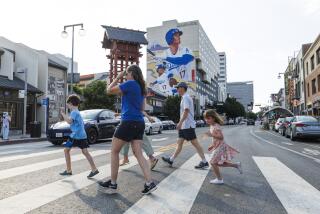Spy Museum Lets You In on the Secret
- Share via
WASHINGTON — Secrecy is its business, but the International Spy Museum opened very publicly Friday with news crews swarming the first day of the nation’s only museum devoted to divulging the tricks of the Stasi, the KGB and the CIA.
A placard in the museum quotes Winston Churchill: “In wartime, truth is so precious that she should always be attended by a bodyguard of lies.” And spies, apparently, should be attended by a few cool gizmos to get the job done.
The museum’s trove of intelligence equipment--about 1,000 artifacts--would make any gadget maven marvel: cipher machines, counterfeit currencies, an umbrella that shoots poison pellets, the “Kiss of Death” lipstick pistol.
One room showcases super-cameras. A German model with a lens as wide as an elephant’s trunk can photograph through a wall. A Zodchi sub-mini camera from the 1980s is the size of a 9-volt battery. The Echo 8 lens is concealed in a cigarette lighter. The Tessina’s lens is tucked inside a brown snakeskin cigarette case.
Exhibits spotlight “spooks” both real and make-believe: a replica of James Bonds’ silver Astin Martin from the movie “Goldfinger” is on prominent display.
Much of the paraphernalia may be vestiges of an earlier era. But the interactive exhibits that test a visitor’s reflexes and observation skills--prized assets of any spy--are distinctly modern.
The museum, not far from FBI headquarters, is housed in a series of five buildings built in the late 19th century. Inside, its walls are steel gray and its decor decidedly spare and modernist.
A circus-like atmosphere prevailed Friday: The “Mission Impossible” theme played as acrobats in trench coats twirled across the face of the building. Washington Mayor Anthony A. Williams played dress-up in a black fedora and fake mustache. And actress Barbara Feldon, “Agent 99” from the 1960s television series “Get Smart,” put in an appearance.
Milton Maltz, a code breaker for the National Security Agency during the Korean War, donated $15 million toward the $40-million project. Private donations and city loans provided the balance in the for-profit venture.
“I’m not good at playing golf or walking the dog on the beach,” Maltz said, explaining his interest in spy culture. Museums “shouldn’t be musty, dusty places. They should be educational, and have a sense of compelling interest.”
As onlookers eager to pay the $11 admission avoided the sun with purses, museum leaflets and wet towels, Maltz read the biographies of the 16-member museum board and council. Among those serving: William H. Webster, the only person to serve as director of both the FBI and the CIA, and Oleg Kalugin, the KGB’s former chief of foreign counterintelligence.
The museum’s executive director, E. Peter Earnest, shared his vision for the museum. “The ranks of spies include some of the biggest rogues in history,” he said. “When you visit, you yourself must judge whether it was for the greater good of history or not.”
Earnest worked for 36 years at the CIA, including 20 years in clandestine services. Holding fast to a spy’s code of conduct, he refused to reveal which Middle East and European countries he had worked in.
In the museum, it’s the “outed” kings and queens of espionage who get star billing.
Captioned photographs and a video display detail their lives. The “Madonna of Espionage,” code name “Sonia,” gave Russia information on the atomic bomb. A British Embassy employee in Washington during WWII earned the title “most valuable agent” for the amount of war information he funneled to Soviet agents.
One display features turncoat FBI agent Robert Philip Hanssen, who pleaded guilty in February 2001 to spying for the Russians.
When he was captured, according to the exhibit, Hanssen quipped to the agents: “ ‘Ha! What took you so long?’ ”
More to Read
The biggest entertainment stories
Get our big stories about Hollywood, film, television, music, arts, culture and more right in your inbox as soon as they publish.
You may occasionally receive promotional content from the Los Angeles Times.










